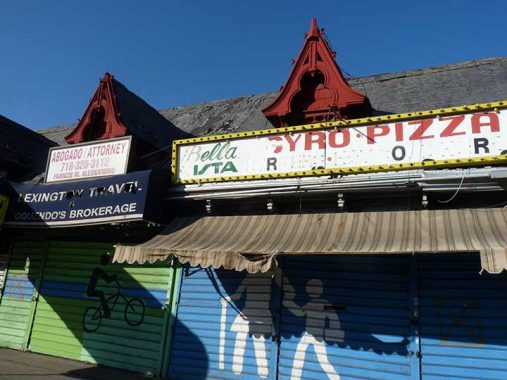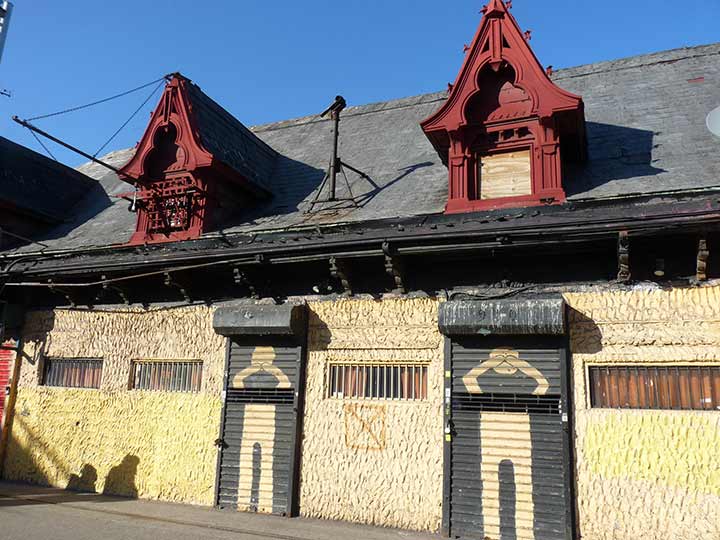
HUNT’S Point in the Bronx, an enclave relatively cut off from Longwood by the Amtrak railroad cut and Bruckner Expressway, is where auto glass, auto parts, light industry and manufacturing are carrying on without pressure from the city. It also brought FNY a much-needed Bronx tour, a borough that has been somewhat neglected lately by the FNY camera — it’s not readily reachable from Little Neck without a couple changes of trains. Your webmaster will try to alleviate the Bronx dearth as I carry on.
Hunt’s Point, not to be confused with Queens’ Hunters Point, is easily definable as it is cut off from the rest of the Bronx by pedal-to-the metal Bruckner Expressway, the East River, and the Bronx River, which divides it from Soundview and Harding Park. It was settled as early as the 1690s by the Leggett and Hunt colonial families, and for many years it was a rural enclave dotted with opulent mansions owned by Edward Faille, Paul Spofford, Cuban patriot Innocencio Casanova and Benjamin Whitlock. The only trace of them now, and other colonial-era names, are words on street signs…
In the early 20th Century, the coming of high-speed railroad lines, as well as the elevated and subway lines, spelled the conclusion of Hunt’s Point’s rural era of exclusivity. Single-family homes and apartment buildings arose along streets in the northern half of the neighborhood, with industry and railyards along the East River to the south. Two of the largest produce markets in the world, the New York City Produce and Meat Markets, opened in 1967 and 1974 respectively. The old Fulton Fish Market joined them in 2007. They are now surrounded by the Hunt’s Point Industrial Park, hosting over 800 businesses and a large Con Ed plant at the southeast end of the neighborhood at East Bay Avenue.
Like the rest of the Bronx, Hunt’s Point suffered a severe decline in the 1970s and 1980s as poverty, crime, arson and a crack cocaine epidemic caused severe privations. The area lost close to two-thirds of its population by 1985. Hunt’s Point continues to struggle out of this malaise as best it can. The opening of the new Barretto Point Park is a sign of hope.

The Hunts Point railroad station, Hunts Point Avenue and Bruckner Boulevard, is a relic of a period when local service was offered on high-speed rail lines in the southern and eastern Bronx, and additionally a relic of the days when grand buildings were constructed even on local stops in areas that were not necessarily in the center city. This station served the New York, New Haven and Hartford Railroad (Amtrak tracks still run underneath Hunts Point Avenue here). It as designed by Cass Gilbert — the architect of the Woolworth Building — in 1908. This is one of a series of deteriorating rail stations in the Bronx along the old New York, New Haven and Hartford Abandoned now, the station has been home to a variety of businesses; lawyers, travel agencies, pizza, fried chicken, groceries, topless.
According to NYC subway and railroad historian Joe Brennan…
The New York, New Haven and Hartford made its entry to New York via the Harlem Line in 1849, but the secondary route known as the Harlem River Branch was opened in 1868 mainly to make freight connections by water with other railroads. Local passenger service was also run until 1931. The line was rebuilt in 1908-1910 to 6 tracks with complete grade separation, and all new stations. It was also electrified. Most of the branch became part of the Hell Gate Route opened in 1917, the main line from Penn Station to Boston, and so it still has intercity trains today run by Amtrak. The portion south of 142d Street is now open for freight only.
(Footnote: From 1876 to about 1906, two passenger trains a day on a Boston-Washington run were carried by lighter (a barge with rails) between the old Harlem River terminal and the Pennsylvania Railroad at Jersey City, without a New York station stop. That unusual operation was then replaced by an inland route over the Poughkeepsie Bridge, and the trains were finally included among those using the new Hell Gate route starting in 1917.)
Though plans call for Metro North service to return to Hunts Point by 2027 (translated, 2040 or so) a new station would be constructed here, instead of rehabilitating this formerly inviting relic of 19th Century railroading.
As always, “comment…as you see fit.” I earn a small payment when you click on any ad on the site.
3/29/23


13 comments
I worked in Hunt’s Point in the 1980’s at 2 great companies:Krasdale Foods (now in Westchester) and Hebrew National Hot Dogs (now in Omaha). The area was run down but I got used to it and after a while it just became just another NY neighborhood, old but with lots of character. Bob
Great posting about a long-forgotten piece of NYC rail transit history. One minor correction is needed – the actual name of the route that served Hunts Point Avenue was the New York, Westchester, and Boston Railroad. Despite its name, it never came anywhere near Beantown and closed for good 86 years ago. Some more historical details follow.
The stations at Hunts Point, as well as three to the south (Harlem River, Port Morris, Casanova) and one to the north (Westchester Avenue), were not really on the New York, New Haven, and Hartford RR, more commonly called the New Haven RR. As Joe Brennan correctly noted, the New Haven’s line was rebuilt in 1908-1910 to 6 tracks. complete grade separation, and all new stations. The stations noted and at least two of the tracks were for the New Haven RR’s subsidiary, the New York, Westchester, and Boston Railroad, more commonly called The Westchester RR. It was an electric commuter railroad that had two Westchester County branches that terminated in White Plains and Port Chester; its southern terminus was at E 133rd St. in The Bronx where passengers transferred to the Third Avenue Elevated to travel into Manhattan. While parent New Haven RR provided direct service between Westchester County and Grand Central Terminal, The Westchester RR did not. As a result it was never profitable, and when parent New Haven RR went into bankruptcy in 1935, the Westchester followed suit. Two years later, at the end of 1937, the Westchester shut down for good.
Five stations and about five miles of tracks from the Westchester’s old route, between E 180th Street and Dyre Avenue, were purchased by NY City in 1941 became part of the NYC subway that year. Originally the line was called the Dyre Ave. Line and featured a two car shuttle with a free transfer to IRT subways at E 180th Street. In 1957, a connection was built between the old Westchester tracks and the IRT at E 18th Street, permitting through subway operation that has continued to this with full length trains. Until 1965 the Dyre Avenue route was served by #2 7th Ave. trains; ever since the #5 Lexington Ave. train has provided all service with one exception. During overnight periods, the Dyre Ave. line is a shuttle between its namesake terminal and E 180th St.
I will be dead, buried and dust before a
Metro North Station at Hunts Point ever
sees the light of day.
I rather agree, which is why I said 2040; at age 65 now, I hope I’m proved incorrect.
Are you the “Twelve Historical New York City Street Transit Maps from 1960-1967” John Landers?
Royalty!
https://www.amazon.com/Twelve-York-City-Street-Transit/dp/188260816X
“I will be dead, buried and dust before a
Metro North Station at Hunts Point ever
sees the light of day.”
A newly hatched Galapagos tortoise would say the same thing, if they, you know, could talk.
It’ll be more a matter of how real estate interests in and around that stretch of track between New Rochelle and the Hell Gate Bridge will want to build something that takes advantage of Hunts Point’s elative isolation. Think, the Long Island City Waterfront. Stops at Co-Op City, the hospitals at Morris Park Av and Eastchester Rd, and Parkchester all could be built and up and running and serving passengers, with Hunts Point being an infill station to be stuck in later.
As a former bus operator, I passed this former station numerous times working the BX6 and BX5 lines
Andy and Kevin are both correct. The New York, New Haven and Hartford had local trains calling here, and so did the New York, Westchester and Boston (which was owned by the New Haven), The two services started at Harlem RIver, not an ideal New York City terminal despite a footbridge connection to the elevated railway.
Maybe they won’t rehabilitate the old station because it might cost more, though I find that to be ridiculous due to finding the reverse to be the case.
Interesting: Bronxlandia!
https://www.bronxlandia.nyc
I grew up in Little Italy (Arthur Ave) The Bronx. I went to PS 59, and PS 45. In 1966 I was sent upstate NY to finish school. The summer of 1968 one of my Brothers came upstate to get me for a summer job in The Bronx,
Hunt’s Point to be exact. I knew nothing about the Hunt’s Point area, I was 15 years old and a green as green can be! I got a job running a D6 Caterpillar to fill in the bay at the foot of Tiffany St. Facing the water standing on Tiffany St. to the left was Colonial Sand and Stone Concrete Co. plant that was abandoned. To the right of Tiffany St. was Petro Fuel Oil. Well from the last week in June, 1968 to Labor Day Weekend in September, I worked 5 days a week pushing dirt, rock, and stones off the lands end. I did that all Summer, most of the dirt and rock was coming from the hole being dug for the World Trade Twin Towers, and other construction jobs in Manhattan. Like I said, I knew nothing of hunt’s Point until 5 years later. I met friends that use to live off of St. Anns Ave, 138th St. It was a run down neighborhood because most all the industrial businesses left the South Bronx. Which
in turn left empty parking lots and no people, it looked like a ghost town at night! I am proud to say that I grew up in The Bronx, and that I am a part of history. I helped create 15 acres of land off the tip of Tiffany St. in
The Bronx, NY